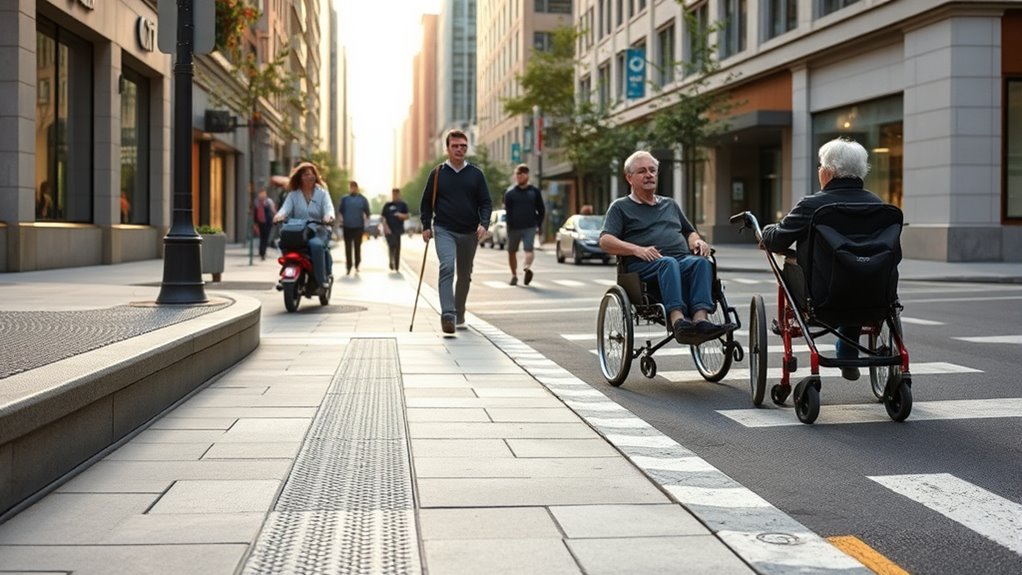You can start applying universal design principles today by making your spaces and products more accessible and welcoming. Use wide doorways, ramps, and non-slip flooring to support mobility. Incorporate adjustable features like lighting and seating for comfort. Consider assistive tech such as automatic doors or voice controls to enhance independence. By designing with empathy and foresight, you’ll create inclusive environments that benefit everyone. Keep exploring to discover more simple ways to make a difference.
Key Takeaways
- Incorporate wide doorways and ramps to ensure easy access for everyone, including those with mobility challenges.
- Use adjustable lighting and seating options to accommodate diverse sensory and comfort needs.
- Design spaces with non-slip flooring and clear pathways to promote safe, unobstructed movement.
- Integrate assistive technologies like automatic doors and voice controls for enhanced independence.
- Observe and gather feedback from diverse users to continuously improve accessibility and usability.

Have you ever wondered how to create spaces and products that everyone can use effortlessly? Universal design principles focus on making environments and items accessible, usable, and welcoming for people of all abilities, ages, and backgrounds. By integrating these principles into your projects, you guarantee that no one is left out. One key aspect is the use of assistive technology, which can be seamlessly incorporated into everyday spaces and products. For example, consider automatic doors, voice-activated controls, or adjustable countertops. These features help individuals with mobility challenges or sensory impairments navigate spaces independently. The goal is to anticipate diverse needs and remove barriers before they even appear. Incorporating accessibility features from the start ensures your design is truly inclusive and user-friendly for everyone.
Design spaces that everyone can access effortlessly with assistive technology and inclusive features.
Inclusive architecture plays a crucial role here. It’s about designing buildings and public spaces that accommodate everyone from the start. Think about wide doorways, ramps with gentle slopes, and non-slip flooring—all elements that contribute to a more inclusive environment. When you prioritize inclusive architecture, you’re not just meeting legal requirements; you’re actively fostering a sense of belonging. It’s about creating spaces where people can move freely and comfortably, regardless of physical or cognitive differences. This approach benefits not only individuals with disabilities but also families with strollers, elderly visitors, or anyone carrying heavy loads.
Applying universal design principles begins with empathy and foresight. Start by observing how different users interact with your space or product. Ask yourself whether someone with limited vision or mobility can access everything easily. Incorporate adjustable features, such as lighting controls or seating arrangements, which cater to personal preferences. Remember, universal design doesn’t mean sacrificing aesthetics; it’s about blending form and function seamlessly. You can select attractive, durable materials that also serve accessibility needs.
Furthermore, educating yourself about assistive technology can open new avenues for innovation. For instance, integrating smart systems that respond to voice commands or allow customization can greatly enhance usability. These technologies promote independence and confidence among users, which is a cornerstone of universal design. When you plan with inclusivity in mind, you’re not only expanding your reach but also demonstrating social responsibility. It’s about recognizing that good design benefits everyone, making the world more equitable and accessible one space or product at a time.
Frequently Asked Questions
How Can I Incorporate Universal Design in Small Spaces?
To make small spaces more functional, you should focus on space-saving furniture that maximizes every inch. Use multi-purpose pieces like fold-away beds or storage ottomans. Incorporate color contrast strategies by choosing light walls and darker furniture, which helps define spaces and adds visual interest. These simple steps improve accessibility and usability, making your small space more comfortable and stylish while embracing universal design principles effortlessly.
What Are Common Mistakes to Avoid With Universal Design?
Did you know that 70% of people find overly complex designs frustrating? When designing for aesthetics, avoid complexity to create accessible spaces. Common mistakes include prioritizing style over function, which hampers usability. Instead, focus on clear, simple layouts that enhance visual appeal without sacrificing accessibility. By steering clear of unnecessary complexity, you guarantee your space is welcoming, functional, and aesthetically pleasing for everyone.
Can Universal Design Principles Be Cost-Effective?
You might wonder if universal design principles are cost-effective. The good news is, they can be if you focus on cost-effective strategies and budget-friendly adaptations. By planning ahead and choosing versatile solutions, you save money long-term. Incorporating simple modifications early on reduces future expenses and makes your space accessible for everyone. So, with thoughtful planning, universal design benefits both your budget and your users.
How Do I Ensure Cultural Inclusivity in Design?
Think of your design as a bridge connecting diverse communities. To guarantee cultural inclusivity, prioritize cultural sensitivity and inclusive communication. Engage with stakeholders from varied backgrounds early in the process, gathering insights that prevent unintentional bias. Use diverse imagery, languages, and symbols thoughtfully. This approach fosters respect, making your design welcoming for all. Remember, inclusive design isn’t just ethical; it broadens your reach and strengthens your impact.
Are There Specific Tools to Assess Universal Design Usability?
You can use assessment tools like checklists, surveys, and usability metrics to evaluate universal design usability. These tools help identify accessibility issues and measure how well your design accommodates diverse users. By applying usability metrics such as task success rate, error frequency, and user satisfaction scores, you guarantee your design meets inclusive standards. Regular testing with these assessment tools keeps your design accessible, functional, and user-friendly for everyone.
Conclusion
By embracing universal design principles, you’re opening doors for everyone—much like a well-crafted bridge that invites all to cross. Imagine designing a space where no one feels left out, just as a good story connects with every reader. When you apply these principles today, you’re building a more inclusive world—one step at a time. Think of it as planting seeds; with patience, you’ll cultivate spaces that welcome and serve all, effortlessly.









